Persian longhair cat after de-matting.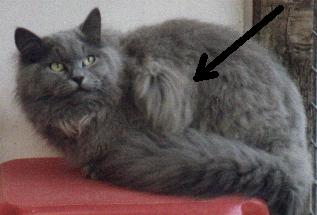
Longhaired cat starting to develop a wing-like mat.

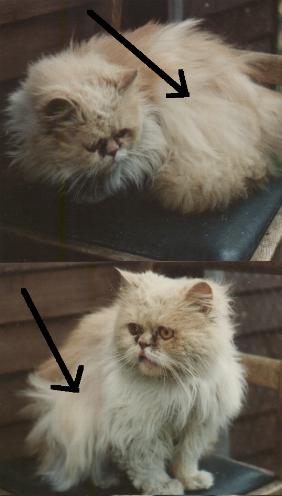

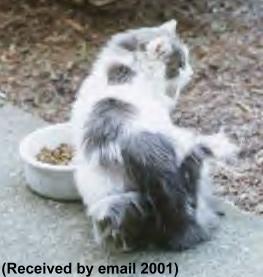
WINGED CATS - VETERINARY REPORTS, CAUSES AND MEDICAL ISSUES
The wings on "winged cats" have several possible causes. Most commonly they are extensive mats of fur which hang from the cat until the whole mat falls away. These furry masses hang from the cats' sides in wide, flat sections until the fur holding them in place is moulted away or the mat is pulled away by becoming caught on thorns. When the cat runs, the mats flap about. Many of the reported winged cats were longhairs which are prone to matting if not groomed regularly. Mats can occur on shorthaired cats as moulted fur adheres to newly grown fur; such mats tend to develop over several moults in the same way that humans grow superglue dreadlocks over many years. The best recorded case of matted fur on a cat is probably "Shaun" the matted silver Persian featured on the UK TV show "Animal Hospital". Cats with hyperthyroidism are more prone to matting because hair growth, like other metabolic processes, is accelerated.
Winged Cats - Recent Reports
Winged Cats - Historical Reports
Winged Cats - Myth, Legend and Fakes
Winged Cats - Vet Reports, Causes and Medical Issues
MATTED FUR / POOR GROOMING
|
Persian longhair cat after de-matting. |

|

|
Throughout the 1990s, I became accustomed to seeing a winged black-and-white longhaired feral cat called "Dorothy". The wings were extensive mats of felted fur, grime and leaf litter held together with saliva which formed in spring and summer. The largest mats extended from shoulder almost to hip and flapped as she ran. These "wings" were eventually shed naturally and some were found to be the size of a small kitten. When possible, Dorothy was trBeing wild, Dorothy could not be groomed. apped, anaesthetised and dematted as the mats were cumbersome and undoubtedly uncomfortable.
In 2005, my hyperthyroid longhaired cat Cindy developed wing-like mats along her midline. Matted fur is common in hyperthyroid cats due to the faster than normal growth of fur and a tendency not to groom. I removed these with veterinary clippers with no need for sedation. In 1991, her shorthaired predecessor Kitty I had developed similar mats on her hips, also due to hyperthyroid.
Matted fur can occur on any part of a cat, but is most easily noticed on the flanks, especially when the cat is in motion and the mats move up and down in a wing-like manner. Mats are considered not noteworthy by experienced cat owners, but matted cats may be reported as winged cats by observers unfamiliar with the condition. Dorothy's "wings" were regularly mentiond by cat shelter visitors.
|
|
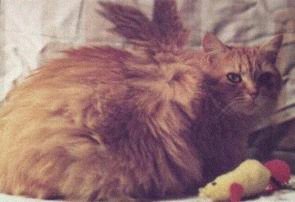 Overweight longhair with mats developing on the back where it cannot reach to groom properly. |
SUPERNUMERARY LIMBS / CONJOINED TWIN
A less common cause is that the fur-covered wings are congenital deformities such as vestigial legs (as found in some forms of conjoined twins), useless for any purpose at all, including flying. Conjoined twins occur when a fertilised egg splits incompletely into 2 parts and can result in animals with extra limbs. An extra pair of forelegs dangling from the shoulders but rudimentary could give the impression of wings and might even "paddle" as the cat ran. A taxidermy is shown of a kitten with additional forelimbs in a wing-like position. This kitten had a more severe form of conjoining and could not survive, but there are two recent cases of stray cats with additional forelimbs surviving to adulthood.
ELASTIC SKIN
The third explanation is a hereditary deformity of the skin that causes pendulous wing-like folds of skin on the cat's back or shoulders. The cat has little or no control over its "wings" and certainly cannot flap them, fly or swoop down from above! In the 1990s, cryptozoologists and veterinarians realised that an uncommon genetic condition explained several cases of winged cats. "Feline Cutaneous Asthenia" (FCA) causes the skin on the cat's shoulders, back, and haunches to be abnormally elastic. Even stroking the skin can cause it to stretch. It forms pendulous folds or flaps which sometimes contain muscle fibres, enabling them to be moved (as in the Trafford park cat, bottom right in the image below) though they cannot be flapped as they contain no supporting bones or joints.
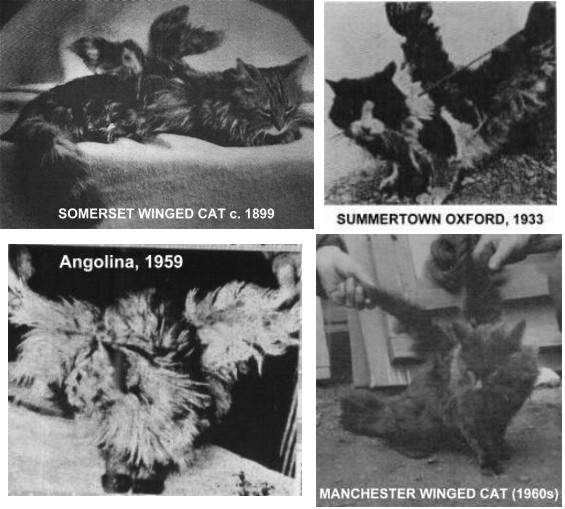
CUTANEOUS ASTHENIA (EHLERS DANLOS SYNDROME, DERMATOSPARAXIS)
Cutaneous Asthenia literally means "weak skin" and refers to the fragility of the skin. It is also called "dermatoproxy," "cutis elastica" ("elastic skin") and "hereditary skin fragility". There are similar conditions in humans, dogs, mink, horses, cattle and sheep. In cattle and sheep the term "dermatosparaxis" ("torn skin") is used. In horses a similar condition is called "collagen dysplasia". The human form is called Ehlers-Danlos Syndrome (EDS) and occurs in several different forms. Elastic-skinned people have exhibited themselves at freak shows, demonstrating the condition by stretching handfuls of their hyperextensible skin away from their bodies. Probable human sufferers include Arthur Loose the "Rubber Skinned Man" whose cheeks and jowls hung in pendulous folds 8 inches (20 cm) long and James Morris the original "India Rubber Man" who could pull his elastic skin 18 inches (44 cm) from his body.
The skin is elastic and forms pendulous flaps which may be shed without apparent damage to the cat. These flaps are covered with fur in the normal manner. The skin is easily torn (often with little or no bleeding) at the slightest contact with anything sharp - rough surfaces or even the cat's own claws when scratching or grooming itself. Lacerations can be caused by an injection needle. Tears usually heal rapidly and the skin and may be criss-crossed with scars. In more severe forms, the tears may enlarge and form large wounds. An interesting aspect of this condition is that the flaps of stretched skin may peel or slough off very easily, often without bleeding. This explains some of the cases where wings were suddenly "moulted". Some forms of the condition also affect the blood vessels in the skin, resulting in bruising and large blood blisters. In dogs, a similar condition appears to be linked to looseness in the joints and to abnormalities of the eye (slipped lens or cataracts).
In mammals, the skin comprises two principal layers. The surface (outermost) layer is the epidermis and is relatively thin. Below the epidermis is the dermis which is thicker and contains connective tissue. The dermis provides support and packing as well as containing nerves and blood vessels. The dermis consists largely of fibres made mostly of a protein called collagen. Collagen binds the cells of the dermis together. Mammals with Cutaneous Asthenia have defective collagen in certain areas of the skin, this makes it incapable of functioning effectively as tissue packing. As a result, the is extremely flexible and fragile in the affected areas. Most usually affected areas are the shoulders, back and haunches and the stretching gives the appearance of wings sprouting from these areas. Where the defect occurs in regions containing sufficient musculature so that muscle is included in the flaps of skin, the wings can even be moved slightly. Where the wings don't contain any muscle, they folds simply bounce up and down as the animal runs, giving the impression of flapping.
The term collagen dysplasia is used for these conditions. These comprise a complex group of disorders of the connective-tissue in the skin. Affected tissue has reduced tensile strength, is hyperextensible, smooth or velvety to the touch, and easily torn. They can be caused by decreased production of collagen or production of a faulty collagen. Microscopic examination of skin samples shows reduced dermal connective tissue consisting of shortened and fragmented collagen fibres. Normal fibres may be intermingled with altered fibres. Ultrastructural changes in collagen fibres include disorientation of fibrils within the same bundle, marked spacing differences, and variation in the diameter of transverse sections. The fibrils maintained the transverse striations characteristic of normal collagen.
FCA remains an uncommon and little-studied condition. There are still only a few cases recorded in veterinary publications although awareness of, and interest in, this condition appears to be growing, particularly as researchers gain greater knowledge of genetics and gene-mapping. A recessive autosomal (non-sex linked) variant FCA has been discovered in Siamese cats and in breeds with Siamese ancestry; in the homozygous state it is apparently lethal (i.e. kittens inheriting 2 copies of the dominant FCA gene do not survive). Because many different genes are involved in putting together of proteins and of skin, there may well be several different genes which cause outwardly identical symptoms. Modern genetic techniques might now allow feline geneticists to work out how many different types of FCA there are.
The recessive form of FCA causes a deficiency in the enzyme "procollagen terminal peptidase". This deficiency causes the collagen fibres to be unable to form a normal tubular shape and to be misshapen and twisted instead. The dominant version of FCA causes the fibre bundles to be disorganised and appears to be lethal in the homozygous state (i.e. embryos inheriting 2 copies of the dominant FCA gene die in utero).
VETERINARY REPORTS OF WINGED CATS
In 1970, Peter Pitchie, a vet in Kent, England, received a 5 month old female tabby cat for spaying. When he attempted to inject an anaesthetic, the cat's skin immediately split. When he shaved the cat's flank for the spaying incision (flank spaying is used in the UK) the skin split again. Further splits occurred when he tried to sew up the first two. He eventually sutured all the splits using a round-bodied needle and despite their dramatic formation they all healed in a straightforward manner.
In 1974, a 4 year-old tom cat, known by the owner to have "fragile skin", was taken to Cornell University's New York State Veterinary College Small Animal Clinic. Dr DV Scott noted that its skin was exceptionally thin and velvety in texture. This velvety texture is typical of the condition in cats. The skin was hyperextensible (extremely stretchy) with a criss-cross network of fine white scars where previous tears had healed. When some fur was clipped from one foreleg so that the vet could take a blood sample, the skin immediately peeled away. This peeling was seen to occur whenever the slightest pressure was applied anywhere to the cat's skin. Investigation showed that the collagen fibres in the cat's skin were abnormal. The fibres were fragmented, irregular and disoriented, with very few normal fibres present
In 1975, an adult female cat examined by W.F. Butler of Bristol University's Anatomy Department was found to have very fragile skin on its body. Studies showed it to have abnormally low levels of collagen in the skin of its lower back. At this time, the genetic nature of skin hyperextensibility and fragility in the cat, and its link to reports of winged cats, was not known.
In 1977, Drs Donald F. Patterson and Ronald R. Minor of the University of Pennsylvania's School of Veterinary Medicine studied a young shorthaired grey tomcat. The cat severely lacerated its skin simply by scratching itself. The skin was found to be delicate and tore easily. It was also extraordinarily elastic and when the fur on the cat's back was gently lifted, it could be extended to a distance above the backbone equal to about 22% of the cat's entire body length! The two vets wrote a paper on the subject and photographs of the cat with the skin gently stretched showed a classic winged cat, identical to those in reported sightings. Because of the difficulties in caring for a cat with an incurable skin fragility problem, the cat's owner donated her pet to the veterinary school. It was mated to 4 long-haired female cats and several of the offspring inherited the condition. Those matings demonstrated that Feline Cutaneous Asthenia was inherited as an autosomal dominant trait. It is not linked to the gender of the kittens (haemophilia in humans is an example of a sex-linked trait) so males and females are equally likely to inherit the trait. All of the affected kittens showed packing defects in their dermis collagen.
There is an additional (undated, possible 1999) veterinary report of a 6 month old non-pedigree tom cat which was taken to the Veterinary Hospital of FMVZ (Universidade Estadual Paulista [UNESP], Botucatu) with two skin wounds on the right hand side of its body. The skin in the affected areas, and the skin on the cat's back, was hyperextensible, smooth and easily torn by just a small amount of pressure. The cat also had signs of rickets, dehydration, pneumonia and breathlessness and died despite treatment. Skin samples were examined under the microscope and revealed abnormally low levels of connective tissue. The collagen fibres were abnormally short or were fragmented. There were some normal fibres mixed in with the abnormal fibres. A more detailed examination of the individual collagen fibres showed that the fibrils (strands, a bit like the strands in a piece of rope) were irregularly sized and irregularly spaced. If you visualise an abnormal fibre as a frayed section of rope and the normal fibre as a new section of rope, you get an idea of why the abnormal ones tear more easily.
Winged cats have been recorded since the 1800s. FCA has been documented since the 1970s. Until the 1990s, no-one had made the connection between the two in spite of the 1977 photo in Drs Patterson's and Minor's veterinary paper. This is not entirely surprising. Cryptozoologists may not have access to, or interest in, veterinary journals about medical or hereditary conditions. Veterinarians are more interested in the creatures they are likely to treat than in reports of mythical beasts which appear mainly in "fringe" magazines. None of the winged cats recorded in those magazines had been documented in the veterinary literature. None of the recorded veterinary cases of had been featured in publications about strange phenomena. Karl Shuker, a cryptozoologist with an interest in medical anomalies, freakish individuals and genetic conditions made the link in 1994. He continues to collect reports of winged cats as do others with an interest in medical curiosities, cat care and geline genetics.
It is usually easy to recognise this condition, due to a young cat suffering excessive and unexplained skin damage or damaging itself through scratching or through play-fighting (or real fighting) with other cats.
LIVING WITH FELINE CUTANEOUS ASTHENIA
In early reports of winged cats, they were frequently exhibited as freaks to make money. If the "wings" are due to matted hair. they will eventually be shed - and expert examination will detect the cause and debunk the winged cat as a neglected cat (with possible cruelty/neglect charges for the owner). If the cause of the wings is FCA, an owner is faced with caring for a cat with all the normal feline behaviours, but with abnormally fragile skin. This means high veterinary bills for treating cuts and tears. Routine treatments such as neutering, microchipping or vaccination are hazardous. Even wearing a collar or walking harness could cause lacerations. The lacerations provide an entry point for bacterial, viral and fungal infections. Although the life expectancy appears to be normal, many affected animals are euthanised due the extensive and expensive care and attention that will be required throughout its life or the problem of infection.
If you are a breeder, the affected cat must not be bred or it will pass on the trait. If neither of the parents has the condition then it is probably due to recessive (hidden) genes and both parents and all of their offspring are potential carriers - none of them should be bred because the trait will probably resurface several generations later.
If own a cat with FCA, you will need to modify its lifestyle and environment to minimise the damage its fragile skin suffers. Cats with FCA can live a full life if the owner is careful and not squeamish about dealing with the inevitable lacerations and possible infections. Activities likely to cause mild trauma must be avoided; this includes playing with other cats, climbing trees, going through undergrowth or any activity which could bring it into contact with rough surfaces or sharp objects. You will need to remove or pad (with foam) any rough or sharp corners and objects in your home, possibly confining your cat to certain areas which can be made safe for it. Its resting places must be well-padded.
If your cat suffers the form of the condition where tears enlarge or skin folds tear away, prompt veterinary attention is necessary to suture or glue any small wounds before they enlarge or become infected. Skin glues or liquid bandages (or spray-on skin) are expensive but avoid stitches. The vet must also treat any other skin conditions, including skin parasites, which may cause your cat to scratch. Flea control is essential as flea bites will cause the cat to scratch.
Declawing of all four paws should be considered on medical grounds - since the cat must live indoors, it may also be safer without claws. If declawing is anathema to you, then rubber claw-caps such as SoftPaws might work. In order to prevent self-mutilation and to protect the skin against environmental dangers, the cat might have to wear clothes - either baby clothes or a specially tailored suit made of stretchy swimsuit fabric and with seams on the outside to prevent abrasions.
You cannot scruff a cat with FCA as the scruff may tear away completely. You must also watch out for joint luxation (slipping joints, such as hip dysplasia) which often occurs as part of the syndrome. Because the body has to do so much more healing of what would be minor scratches in other cats, the affected cat will probably need vitamin supplements to promote skin growth, anti-inflammatory drugs to combat certain skin conditions and antibiotic treatments.
HUMAN CUTANEOUS ASTHENIA
There are a number of cases of human cutaneous asthenia described in medical texts. The following is adapted from "Anomalies and Curiosities of Medicine" written in 1896 by George M Gould & Walter L Pyle.
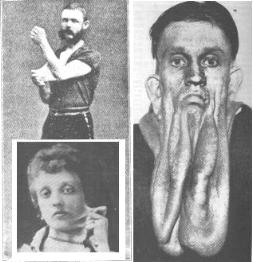
"Abnormal Elasticity of the Skin. In some instances the skin is affixed so loosely to the underlying tissues and is possessed of so great elasticity that it can be stretched almost to the same extent as India rubber. There have been individuals who could take the skin of the forehead and pull it down over the nose, or raise the skin of the neck over the mouth. They also occasionally have an associate muscular development in the subcutaneous tissues similar to the panniculus adiposus of quadrupeds, giving them preternatural motile power over the skin. The man recently exhibited under the title of the “Elastic-Skin Man” was an example of this anomaly. The first of this class of exhibitionists was seen in Buda-Pesth some years since and possessed great elasticity in the skin of his whole body; even his nose could be stretched. [The bearded man] represents a photograph of an exhibitionist named Felix Wehrle, who besides having the power to stretch his skin could readily bend his fingers backward and forward. The photograph was taken in January, 1888.
In these congenital cases there is loose attachment of the skin without hypertrophy, to which the term dermatolysis is restricted by Croeker, Job van Meekren, the celebrated Dutch physician of the seventeenth century, states that in 1657 a Spaniard, Georgius Albes, is reported to have been able to draw the skin of the left pectoral region to the left ear, or the skin under the face over the chin to the vertex. The skin over the knee could be extended half a yard, and when it retracted to its normal position it was not in folds. Seiffert examined a case of this nature in a young man of nineteen, and, contrary to Kopp’s supposition, found that in some skin from over the left second rib the elastic fibres were quite normal, but there was transformation of the connective tissue of the dermis into an unformed tissue like a myxoma, with total disappearance of the connective-tissue bundles. Laxity of the skin after distention is often seen in multipara, both in the breasts and in the abdominal walls, and also from obesity, but in all such cases the skin falls in folds, and does not have a normal appearance like that of the true 'elastic-skin man'.”
FURTHER READING